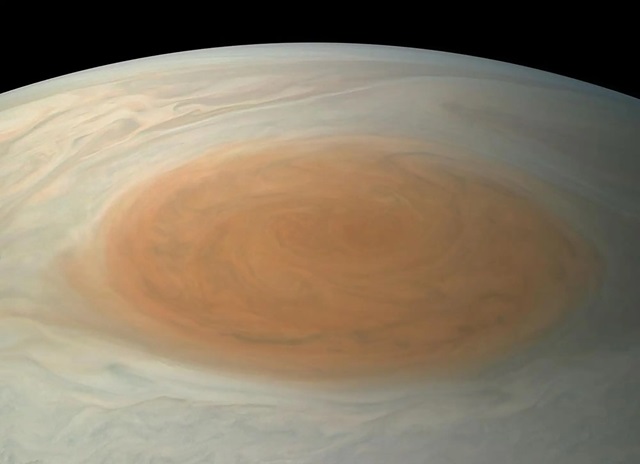NASA has released a stunning new true color image of Jupiter’s Great Red Spot which was captured by its spacecraft Juno from a distance of just 8,648 miles (13,917 km) away from the planet. Scientists believe that our solar system’s most iconic storm has existed for over 350 years, said NASA; however, data suggest that the storm is shrinking, its height diminishing by an eighth and its width by at least a third since it was measured by our Voyager spacecraft in 1979.
The Great Red Spot appears in the center of the news image, as wisps of red, tan, and orange appear to spiral in the storm. The planet’s horizon arcs gently in the upper part of the photo, contrasting the beige, brown, and a hint of blue colors of the gas giant with the blackness of space.
Jupiter’s Great Red Spot is a giant, anticyclonic storm system, meaning it rotates counter-clockwise, in the Southern Hemisphere of Jupiter at a rate of about one rotation every six Earth days. It is the largest storm in the Solar System, and has been continuously observed for at least 350 years. The winds within the Great Red Spot can reach speeds of up to 432 kilometers per hour (268 mph).
Will you offer us a hand? Every gift, regardless of size, fuels our future.
Your critical contribution enables us to maintain our independence from shareholders or wealthy owners, allowing us to keep up reporting without bias. It means we can continue to make Jewish Business News available to everyone.
You can support us for as little as $1 via PayPal at office@jewishbusinessnews.com.
Thank you.
The exact cause of the Great Red Spot’s red color is unknown, but it is thought to be caused by complex chemical processes involving sunlight and Jupiter’s atmosphere. The Great Red Spot is constantly changing in size and shape, but it is always very large. At its largest, the Great Red Spot has been known to be big enough to swallow several Earths.
The Great Red Spot is twice as large as Earth, and recent studies by NASA’s Juno indicate that the storm plunges around 200 miles (300 km) beneath the planet’s clouds. With no solid ground on Jupiter to weaken storms, winds in the Great Red Spot peak at about 400 mph (643 kph).
The Juno spacecraft, which entered orbit around Jupiter on July 4, 2016, is the first explorer to peer below the planet’s dense clouds to answer questions about the gas giant itself and the origins of our solar system. Now in an extended mission phase, the agency’s most distant planetary orbiter continues its investigation.




